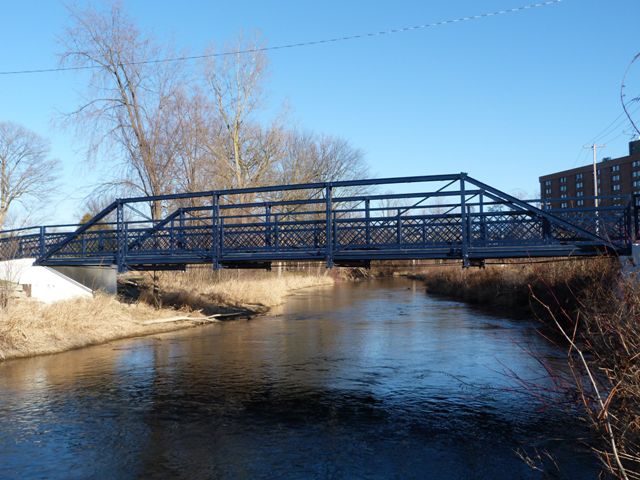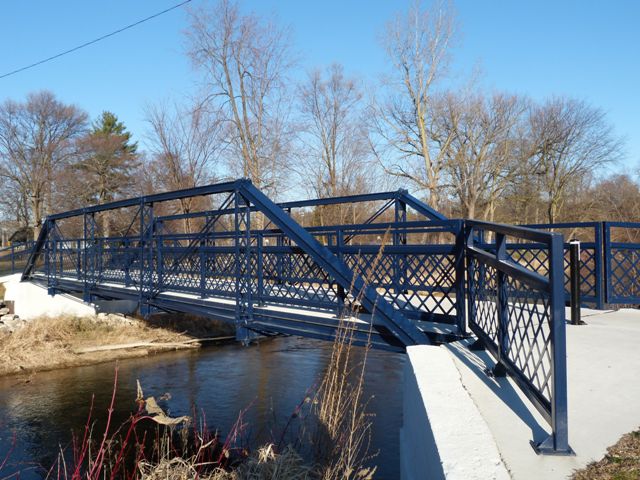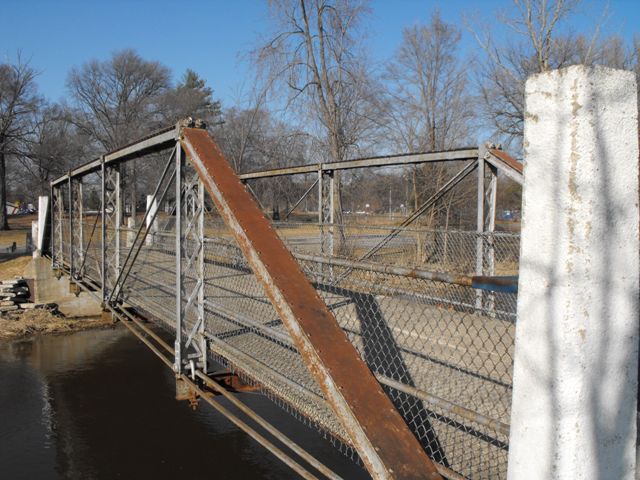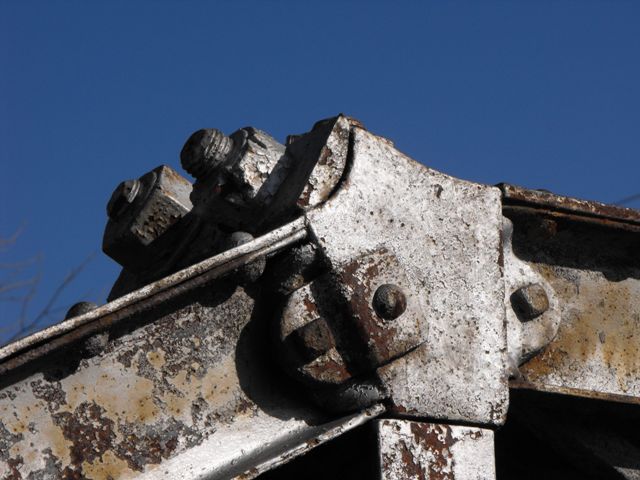We Recommend:
Bach Steel - Experts at historic truss bridge restoration.
BridgeHunter.com Phase 1 is released to the public! - Visit Now
Oak Street Bridge
Island Park Bridge

Primary Photographer(s): Nathan Holth
Bridge Documented: March 15, 2009, December 26, 2011, May 11, 2015, and November 13, 2021
Mt. Pleasant: Isabella County, Michigan: United States
1890 By Builder/Contractor: Wrought Iron Bridge Company of Canton, Ohio
2010
69.6 Feet (21.2 Meters)
70.5 Feet (21.5 Meters)
10.5 Feet (3.2 Meters)
1 Main Span(s)
Not Applicable

View Information About HSR Ratings
Bridge Documentation
About This Bridge
Note: The above listed construction date is a circa estimate based on the style and builder of the bridge.

This bridge is a five panel pin-connected pony truss bridge. Details on the bridge suggest it was built in 1890. Its first remaining recorded history tells that this bridge was built in 1910 to provide access to Island Park at Lincoln Street. Based on the c. 1890 design it appears more likely that this bridge was relocated from somewhere else to serve at the park in 1910. In 1915, the Oak Street Bridge, a wooden structure collapsed. At this time, the truss bridge was moved from Lincoln Street to the Oak Street crossing, where it has remained to this day. The Lincoln Street crossing was rebuilt as a concrete arch, a structure that also remains today, albeit with altered railings.

With the distinctive details of a bridge built by the Wrought Iron Bridge Company in ca. 1890, the bridge is one of the only surviving bridges in Michigan with cast iron details. These details include the bridge shoe and connection assemblies at the bearing, where the bottom chord attaches to the end post with a threaded rod and nut connection. Similarly, the top chord connection to the end post and hip vertical includes diagonals and hip verticals that connect via a threaded rod and nut connection, held by a cast iron connection assembly. The bridge is also noted for its excellent historic integrity with the loss of original railings being the only noteworthy loss of original material and design. Like a number of bridges built by the Wrought Iron Bridge Company, the cast iron pieces of the bridge as well as the eye bars and the ends of some of the pins have part numbers on them. There are a few numbers found, but 121 is most common. Also, unusual marks, found in groups of three or four markings around the top chord connections at the end post are visible. These may be some sort of mark from the fabricator that aided in assembly of the bridge in some manner.
In 2010 the bridge was restored for continued non-motorized use. The truss was repainted, and ugly cyclone fence railings were replaced with a modern ADA compliant railing design that Michigan has used on a number of historic bridges which is noted for its use of a historical lattice design. Note that the original railings, likely a pipe or lattice hub guard, had already been long ago removed. Original American Standard beam floor beams were retained on the bridge but were strengthened by bolting some channels onto them. The bridge also received a new concrete deck along with new deck stringers. The bridge today is ready for another century of use and is a beautiful link between downtown Mt. Pleasant and Island Park, a large, attractive, and functional park that has multiple facilities including a non-motorized trail (which the bridge connects to), a skate park, playgrounds, picnic facilities, etc.
The bridge's parts are configured as follows. Top chord: back-to-back channels with cover plate and battens; End post: back-to-back channels with cover plate and battens; Verticals: two rolled T sections connected by a single row of lattice; Diagonals: paired loop-forged eye bars; Bottom chord: paired loop-forged eye bars; Floor beams: rolled American Standard Beam type i-beams; Deck: concrete deck with corrugated steel base supported by wide flange i-beams; Railing: modern lattice design; Abutments: concrete.
Learn more about the Wrought Iron Bridge Company, its people, and its legacy, on this bridge page.
Why This Historic Bridge Is Important and Why This Historic Bridge Was Restored

In 2009, the city of Mt. Pleasant wanted to improve the condition of this crossing, which was in use for non-motorized vehicles only, potentially including expanding it to accommodate either light or fully loaded vehicular traffic. Initial considerations tended to lean toward building a new bridge capable of handing heavy emergency traffic, and likely demolishing the historic bridge. However, after serious consideration, the city later decided to inspect the bridge so that the feasibility and cost of restoration of this bridge, either for light vehicular or continued pedestrian use may be considered. It was then decided to instead restore the historic bridge for use by non-motorized vehicles, with the capability to support light motorized vehicles in the event of an emergency in the park.
Prior to the decision to restore this bridge in 2009 and 2010, HistoricBridges.org visited this bridge, documented it, and composed the below narrative in an effort to raise awareness about the design, history, and significance of the bridge. The below narrative, which describes the significance of the bridge and the benefits of preservation was read and considered by members of the city council during the decision making process.
The Oak Street Bridge is a very important bridge, especially
for Michigan and it should be preserved for three main reasons.

The first and foremost reason is that the bridge, among Michigan's diverse collection of historic bridges, has a high level of historic significance and integrity. Based on information available on the bridge and an inspection of the bridge, the bridge is most likely the product of the Wrought Iron Bridge Company of Canton Ohio, dated c. 1890. During the c. 1890 period, the Wrought Iron Bridge company built a number of pony truss bridges in the country that used a unique design. While overall, the bridges were pin-connected, the connections at the end posts featured chords and members that terminated at the ends with threaded rods, to which large bolts were attached, forming a special type of bolted connection. Note that this is significantly different than a modern bolted connection where members are bolted with numerous bolts to a gusset plate. In addition, these connections had cast brackets/braces to connect and steady the actual top chord and end post together. Because the Oak Street Bridge contains these distinctive details, this bridge can be associated with the Wrought Iron Bridge Company even though no builder plaque survives on the bridge.
The bridge also appears to retain an extremely high level of historic integrity, particularly the actual trusses themselves, which is the most important part of a historic truss bridge. Historic integrity means that the materials that make up the truss are original and have not been altered. The physical condition of these original materials seems to be very good also, suggesting that a restoration of this bridge could largely take place without removing original parts or otherwise altering the bridge's design. There are only two noteworthy alterations on the bridge. The first is the lack of original railings on the bridge. The second alteration noted was the concrete deck surface, since most pre-1900 bridges had a wooden deck surface. This is a minor and reversible alteration, and does not affect the way the truss functions, and moreover, the metal beams that support this concrete deck, DO appear to be original. The concrete deck likely dates to the 1915 relocation of this bridge to its current location, since a deck is often removed when a bridge is relocated. In addition, this theory is supported by the fact that the dirt approach and its railings feature concrete design that seem to match the deck.
Because this bridge exhibits the unique, and innovative
details of a particular bridge company, and also retains a high degree of
historic integrity, it has a large amount of historic significance. It is also
the only known example of a bridge displaying these details remaining in
Michigan, which enhances its significance on a statewide basis. The bridge
is likely eligible for listing on the National Register of Historic Places under
Criterion C as a result. In addition, the Island Park Bridge is also locally
noteworthy as the last truss bridge in Isabella County, making it very
significant locally.

The second reason to save this bridge is that the bridge is in a location where
many people can enjoy it. Historic metal truss bridges such as the Island Park
Bridge with their complex trusses and beams, are beautiful forms of geometric
art, something not generally found on the overly simple bridges built today.
Rather than having a simple, mundane crossing, visitors to the park can not only
use the bridge as a functional access to the park and downtown, but they can
also enjoy crossing a beautiful structure that is rich in history. The bridge
does appear to be popular for pedestrians to use. It is in a logical location,
connecting the park to downtown Mt. Pleasant.
The third reason to save the bridge is that by preserving this bridge, Mt
Pleasant can help put an end to a pattern of historic truss bridge demolition
that is resulting in a rapid, devastating loss of metal truss bridges across the
country. There are all sorts of statistics that show how fast the number of
remaining metal truss bridges in the country are dropping... it is so fast it is
frightening. Current funding and laws make it easy for agencies to demolish and
replace bridges, even if repair/restoration might actually be less expensive. In
contrast, historic bridges in general receive only limited protection and
funding from the government, which are often ineffective at saving more than a
extremely small percentage of historic bridges. The only serious preservation
programs and attention has always unfairly gone to wooden covered bridges. The
best example is that there is a federal program called National Historic Covered
Bridge Preservation Program. As the name suggests, it only offers funding for a
single structure type, ignoring the vast number of other historic bridge types,
such as metal truss bridges.
With all this being said, it is important to note that while Michigan has a lesser total number of truss bridges than some states like Ohio and Pennsylvania, Michigan has a much better track record at preserving the truss bridges it does have, often making use of the one reliable funding program that has been applied to historic bridges with repeated success, the Transportation Enhancement Grant. Many agencies and groups have had good success securing funds for historic bridge preservation, when they put forth the effort. As such, it may be possible for Mt. Pleasant to secure a Transportation Enhancement Grant to help fund preservation of this historic bridge.

This bridge is tagged with the following special condition(s): Unorganized Photos
![]()
Photo Galleries and Videos: Oak Street Bridge
2011 Structure Overview
Original / Full Size PhotosA collection of overview photos that show the bridge as a whole and general areas of the bridge. Taken after bridge restoration. This gallery offers photos in the highest available resolution and file size in a touch-friendly popup viewer.
Alternatively, Browse Without Using Viewer
![]()
2011 Structure Details
Original / Full Size PhotosA collection of detail photos that document the parts, construction, and condition of the bridge. Taken after bridge restoration. This gallery offers photos in the highest available resolution and file size in a touch-friendly popup viewer.
Alternatively, Browse Without Using Viewer
![]()
2011 Structure Overview
Mobile Optimized PhotosA collection of overview photos that show the bridge as a whole and general areas of the bridge. Taken after bridge restoration. This gallery features data-friendly, fast-loading photos in a touch-friendly popup viewer.
Alternatively, Browse Without Using Viewer
![]()
2011 Structure Details
Mobile Optimized PhotosA collection of detail photos that document the parts, construction, and condition of the bridge. Taken after bridge restoration. This gallery features data-friendly, fast-loading photos in a touch-friendly popup viewer.
Alternatively, Browse Without Using Viewer
![]()
2009 Structure Overview
Original / Full Size PhotosA collection of overview photos that show the bridge as a whole and general areas of the bridge. Taken before bridge restoration. This gallery offers photos in the highest available resolution and file size in a touch-friendly popup viewer.
Alternatively, Browse Without Using Viewer
![]()
2009 Structure Details
Original / Full Size PhotosA collection of detail photos that document the parts, construction, and condition of the bridge. Taken before bridge restoration. This gallery offers photos in the highest available resolution and file size in a touch-friendly popup viewer.
Alternatively, Browse Without Using Viewer
![]()
2009 Structure Overview
Mobile Optimized PhotosA collection of overview photos that show the bridge as a whole and general areas of the bridge. Taken before bridge restoration. This gallery features data-friendly, fast-loading photos in a touch-friendly popup viewer.
Alternatively, Browse Without Using Viewer
![]()
2009 Structure Details
Mobile Optimized PhotosA collection of detail photos that document the parts, construction, and condition of the bridge. Taken before bridge restoration. This gallery features data-friendly, fast-loading photos in a touch-friendly popup viewer.
Alternatively, Browse Without Using Viewer
![]()
Additional Unorganized Photos
Original / Full Size PhotosA supplemental collection of photos that are from additional visit(s) to the bridge and have not been organized or captioned. This gallery offers photos in the highest available resolution and file size in a touch-friendly popup viewer.
Alternatively, Browse Without Using Viewer
![]()
Additional Unorganized Photos
Mobile Optimized PhotosA supplemental collection of photos that are from additional visit(s) to the bridge and have not been organized or captioned. This gallery features data-friendly, fast-loading photos in a touch-friendly popup viewer.
Alternatively, Browse Without Using Viewer
![]()
Maps and Links: Oak Street Bridge
Coordinates (Latitude, Longitude):
Search For Additional Bridge Listings:
Bridgehunter.com: View listed bridges within 0.5 miles (0.8 kilometers) of this bridge.
Bridgehunter.com: View listed bridges within 10 miles (16 kilometers) of this bridge.
Additional Maps:
Google Streetview (If Available)
GeoHack (Additional Links and Coordinates)
Apple Maps (Via DuckDuckGo Search)
Apple Maps (Apple devices only)
Android: Open Location In Your Map or GPS App
Flickr Gallery (Find Nearby Photos)
Wikimedia Commons (Find Nearby Photos)
Directions Via Sygic For Android
Directions Via Sygic For iOS and Android Dolphin Browser
USGS National Map (United States Only)
Historical USGS Topo Maps (United States Only)
Historic Aerials (United States Only)
CalTopo Maps (United States Only)







